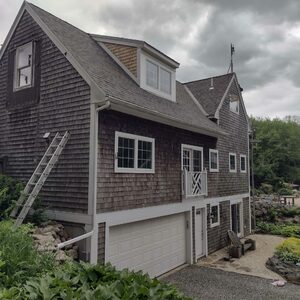Anyone have experience with Superior Walls for foundations? <!—-><!—-><!—->
This is a pre-cast concrete foundation wall system that sits on a gravel footer; sections are bolted together with a sealant between the panels.<!—-><!—->
I am looking for any real world experience with this product.
<!—-> <!—->
http://www.superiorwalls.com/pdf/R5ProductSheetFinal4April05.pdf



















Replies
Muttly,
The Search function shows this to be an oft discussed topic. Here's one link.
http://forums.taunton.com/tp-breaktime/messages/?msg=85671.1
personally, I know nothing, but in another forum, I have seen a tremendous number of complaints about them, but My conclusion was that this was a local anomaly and that like many products, much depends on the contractor and prep work
Welcome to the
Taunton University of Knowledge FHB Campus at Breaktime.
where ...
Excellence is its own reward!
I know they are expensive. I priced them out for a couple of houses I build last year. the Poured foundations cost me $10,800. the Superior walls would have cost me $18,500. That being said, If I were building for myself, I would use them in a heart beat. There are several major advantages to them. First, you can dig and install them the same day, and be framing immediately (assuming you can pour your floor later). Second, they are 5500 psi concrete. Concrete becomes water-proof at I beleive 5000 psi. you would be fortunate to get 4000 psi concrete in a regular poured foundation and even then, it takes 28 days to acheive that design strength. the superior walls are already cured. Third, they come insulated and with wood studs and pre bored holes for wiring for finishing the interior. Fourth, they are 9' tall, so there is plenty of ceiling height in the basement. The one thing that most builder say is "but they don't have a footing. But you have to think of the foundation as a whole. Like one giant piling. It's the surface area on the walls that hold the foundation from sinking, not the footing. The footing merely serves as a level surface for building a conventional foundation. they need to be installed properly though. The gravel must be uniform and compacted properly, the backfill needs to be uniform and compacted properly as well. You can jsut let it settle in like a conventional foundation. As far as experience with them, I've never seen one leak, shift, or crack. The first one that I had seen was only about 5 years ago though. Maybe in 10 more they will begin to have problems, but I can't say.
Edited 2/13/2007 12:56 pm ET by rnsykes
Recently, at a home show, I saw a similar wall system:
http://www.oasiswall.com
That one claims 6,000 psi concrete. Otherwise it is similar: top and bottom bearing flanges 10" wide, concrete ribs 24" oc, built-in insulation (3" EPS in the cavities, plus 1" board over whole of inside; total wall R-10). Difference: delivered with inside covered with DensArmor drywall, claimed ready to tape and paint.
Somewhere I found a report that showed water permeability of concrete as a function of either water content or cement/sand ratio, or something like that. Most concrete poured in place remains somewhat porous, letting dampness migrate through it. On the curve shown in the report, the permeability was somewhat U-shaped, and at the right ratio the permeability bottomed out at near zero. Whether or not that bottom value is small enough to eliminate the need for vapor barrier I can't say.
My problem with perhaps using something like this on a project coming up in a couple of years is access to the site by the large trucks used to deliver the sections. The downloadable document spoke of an 80,000 lb vehicle consisting of tractor and 55' trailer. Tight turns in the road in may preclude that. One thing I noticed in the Superior installation guide, which I didn't see in the one for the Oasis wall (oversight?), was the need for a shear wall that could be needed if the total wall length got too long for the unbalanced fill against it. Having a piece of wall in the basement at 90 degrees to the foundation wall doesn't look too appealing.
"Like one giant piling. It's the surface area on the walls that hold the foundation from sinking, not the footing. The footing merely serves as a level surface for building a conventional foundation. they need to be installed properly though"Point taken there, but needing clarification - if soils are not capable of supporting the load on the structure on the provided base, it will shift and settle. There are soils here where we sometimes must use a wider footing to support the building.
Welcome to the Taunton University of Knowledge FHB Campus at Breaktime. where ... Excellence is its own reward!
your absulutely right, but that should be determined long before an in-adequare foundation is installed. On a set of drawings from the architect or engineer, there should be a note somewhere that lists the minimum soil bearing capacity. Superior walls should see this and advise agains their product if there is a problem.
It's the surface area on the walls that hold the foundation from sinking, not the footing.
I'm not sure what you mean - are you saying it's the "foot" of the wall that bears the weight, with or without a footing, so that if a wall has sufficient area it doesn't need a separate footing?
That's sort of true, but in addition to supporting the weight of the building the footer also provides resistance to the wall turning over.
No, not the base of the wall, the sides. I'm having a hard time explaining it. It's the friction and the force of the soil pushing in around the sides on the foundation that support most of the weight. Not hat the footing doesn't bear any of this, it does. But in the case of the superior walls, it's not needed. As far as the wall turing over, I should certainly hope not. In a traditional foundation, all the walls are connected. Poured uses re-inforcement, and blocks are woven, and both types use the first floor decking to tie everything together. theoretically that makes the foundation on whole unit. the whole thing would have to either turn as a whole, or break into seperate peices in which case there are serious problems that have already surpassed the footing.
From two replies:
85671.9 in reply to 85671.4
It's the surface area on the walls that hold the foundation from sinking, not the footing.
I'm not sure what you mean - are you saying it's the "foot" of the wall that bears the weight, with or without a footing, so that if a wall has sufficient area it doesn't need a separate footing?
That's sort of true, but in addition to supporting the weight of the building the footer also provides resistance to the wall turning over.
--------------
Aren't we getting some serious misinformation here? Piffin already tried politely to challenge the first bit. There is no way that soil friction on the vertical foundation wall will hold up the wall from sinking. Many foundations have much of the foundation wall above grade, and some basements have short poured walls, with framing above. The purpose of a poured footing is to provide a level platform for mounting the forms for the wall and to provide more bearing area for the weight of what will be above, according to soil conditions or the local BI. In the case of the precast walls, the walls bear directly on compacted stone, and the thicker the layer of stone the wider the effective bearing area.
As for the footing keeping the wall from turning over, there may be some slight resistance to overturning there, until backfilling is done. It is the connection to adjacent walls at 90 degrees, plus the attachment of the building platform at the sills, that prevent overturning.
Here is a house sitting on a Superior Walls foundation. Because of the large runs of stone wainscot walls, the number of corners, and the large runs of frostwalls, also requiring stone ledge, Superior Walls was the least cost of all the competitive quotes. The footprint is about 90 by 80 feet.
As for wall bearing, I suggest you read the very large and comprehensive engineering document offered by Superior Walls, which should be fully digested by the builder and his engineer, before planning a build.
View Image
I used them for a 900 sq. ft. addition with a walkout basement and garage on the home we live in 4 years ago. They have been competitive with the poured wall guys around here (Central Ohio) when you consider that the basement will have to be insulated to meet the US DOE energy standards. The only problem we had was that one of the wall sections did not include the drop for the garage door. It took us around 5-6 weeks to get the correct section to complete the garage. Pricing was still competitive when we had them quote another project this past summer.